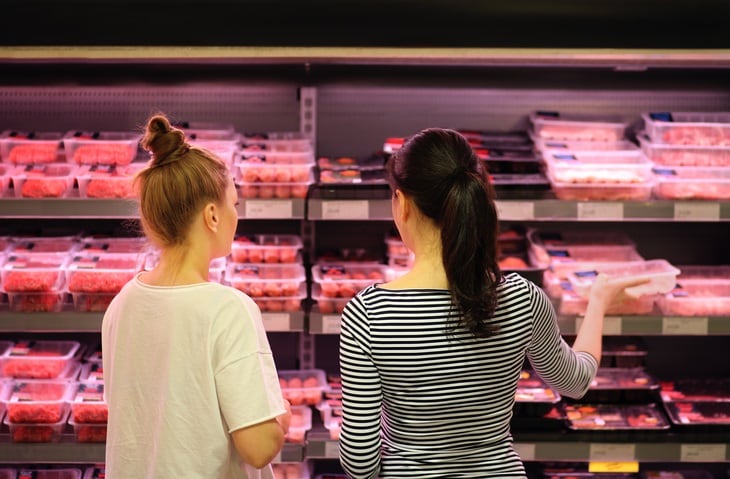Based on in-depth interviews, shop-alongs, dine-alongs and a survey of more than 11,000 consumers, including 2,000 Latino and Hispanic shoppers, research commissioned by the National Pork Board released this month reveals nearly half of Hispanics and Latinos do not shop at mainstream retailers as their “go-to store,” opting instead of specialty stores, ethnic markets and bodegas.
The research revealed a major contributing factor to this decision is the meat case and the fact that most mainstream grocery stores do not stock the cuts or options that play a central role in traditional Hispanic and Latino cuisine, José de Jesús, director of multicultural marketing for the National Pork Board, told FoodNavigator-USA. As a result, he added, 44% of Hispanics and Latinos choose to buy their fresh meat at non-mainstream grocery stores.
“For the retail industry, there is a unique opportunity here to capitalize with this audience. Latinos are shopping more often than anybody else, but they are also leaving stores at a greater rate from a go-to store perspective than non-Hispanics in part because they can’t find what they are looking for,” he said. “Retailers need to understand who their consumer is and offer them what they need. If they do, and if they build a relationship with them, they will come and shop there and love you. … But if you don’t, they will continue to jump around from store to store to find what they are looking for” and a potentially lucrative opportunity will be lost.
This threat extends to the pork industry at large because while Hispanic and Latino shoppers in general are very loyal, “there is only so loyal they will continue to be if they can’t find what they are looking for,” de Jesús warned.
He explained that while the National Pork Board’s research also revealed that Hispanics and Latinos have a strong affinity for pork with 87% reporting they like it, which is higher than any other protein, and higher than non-Hispanic markets, their connection with the segment is waning as they become more acculturated in the US and face continuous sourcing struggles.
To avoid a missed opportunity, the National Pork Board outlines in its report, ‘Time to Tango: Latinos are Pork’s Future,’ three key strategies to help retailers – and other stakeholders throughout the supply chain better engage with and capitalize on the demands of US Hispanic and Latino shoppers.
Improve access to culturally relevant products
The first strategy that will help not only the pork industry but also retailers build a stronger relationship with Hispanics and Latinos is to improve access to the product assortment that members of this community want, de Jesús said.
He explained that while most retailers and packers offer pork chops, for example, they often are not as thin as is traditionally used in Hispanic and Latino cultures, which can frustrate shoppers from this group and make it more difficult for them to prepare traditional dishes.
“Ribs are another example. Normally you see them as a full slab, but we know from the research that Latinos use pork as an ingredient more so than non-Hispanics. So, what that tells us, is they are looking for a product that is more familiar to them. So, can we pre-cut them and make them available in smaller portions for stews and soups?” de Jesús asked.
Beyond making more variety available, retailers can better engage with Hispanics and Latinos by hiring in-culture staff who consumers feel comfortable asking for help if they don’t know the English name of a cut they want or if they are looking for something specific related to their culture or heritage, de Jesús said.
Similarly, he recommends retailers offer products and spices that appeal to Hispanics and Latinos throughout the store and not limit their options to a single aisle.
Create a hyper-local strategy that targets authenticity
Retailers and pork producers also can better engage with Hispanic and Latino shoppers by offering more convenient solutions that are authentic and tailored to shoppers’ cultural heritage, de Jesús said.
He explained that while two of three Hispanics and Latinos in the US originally come from Mexico, a third of the population comes from other nations and by offering products that are specific to their culture or heritage retailers and pork producers can earn their loyalty.
For this to work, retailers and producers need to know exactly who is buying their product and what their cultural affiliations are, de Jesús said.
Stores also need to offer culturally relevant products beyond the meat case to include appropriate spices, sauces, marinades, produce and the typical foods that are served with pork or other proteins.
Address health concerns
The third strategy for retailers and pork producers to better engage Hispanic and Latino shoppers is to directly address their concerns about the nutritional value of pork, de Jesús said.
He explained that the study found nearly two-thirds of unacculturated Hispanics perceive pork as unhealthy, which is a “big problem for the industry.”
Retailers and producers can address this by educating consumers about different lean cuts, including two – sirloin and tenderloin – that are certified by the American Heart Association as extra lean.
He also recommends producers and retailers work together to increase educational signage in stores.
By taking these three steps, de Jesús said, pork producers and retailers can better engage with Hispanic and Latino shoppers and in doing so gain access to a currently untapped but potentially highly loyal consumer base with a rapidly growing spending power.




